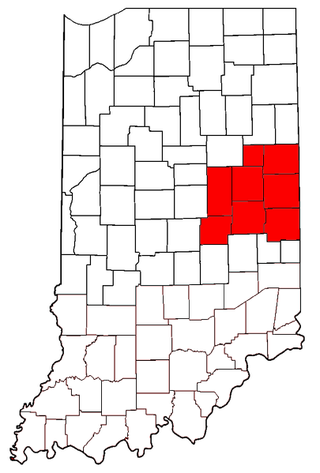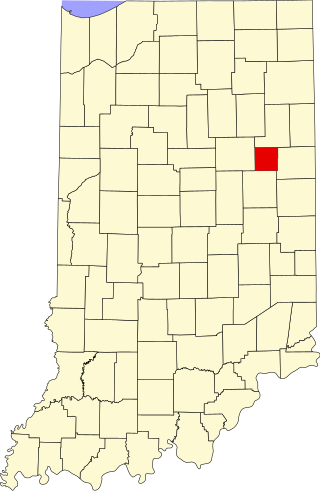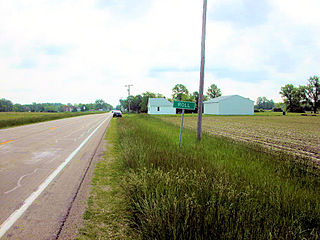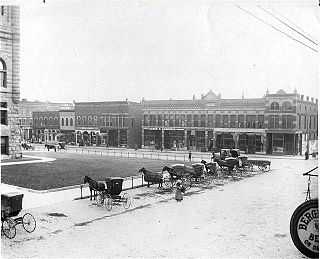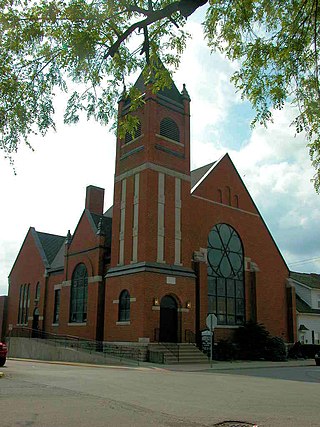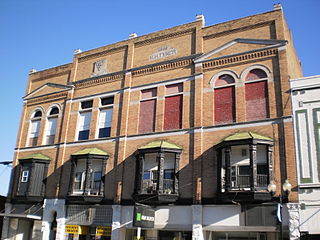Contributing properties
These properties are contributing properties to the Hartford City Courthouse Square Historic District. In general this means that they add to the historic character of the historic district. In the case of this historic district, the property is associated with architecture, commerce, politics, government, or social history.
| Property name | Address | Built | Architecture | Image | Notes | ||
|---|---|---|---|---|---|---|---|
| 1 | Blackford County Courthouse | Courthouse Square | 1894 | Romanesque Revival Richardsonian Romanesque |  | Focal point of town. Outstanding historic or architectural significance. Outstanding example of Richardsonian Romanesque architecture. Listed in National Register of Historic Places. | |
| 2 | World War I Memorial | Courthouse Square | 1921 | Sculpture |  | Twenty foot high bronze sculpture created by Ernest Moore Viquesney and known as the Spirit of the American Doughboy. Unveiled September 28, 1921. | |
| 3 | First Presbyterian Church | 220 N. High St. | 1893 | Romanesque Revival Richardsonian Romanesque |  | Also uses 117 W. Franklin Street as address. Oldest church building in town. Outstanding example of Richardsonian Romanesque architecture. Listed in National Register of Historic Places. Outstanding stained glass windows and history with city's glass industry. [3] | |
| 4 | Commercial Building | 211 N. High St. | circa 1910 | Two-part commercial block listed as 213-215 N. High in National Register, current address for building is 211 N. High, Interim Report lists as 211 N. High. Taller building with mini-van parked in front in photo. Peoples Gas and Oil Company had an office at the 213 North High Street address in 1903. [4] | |||
| 5 | Commercial Building | 209 N. High St. | circa 1910 | Smaller building to right of white building in left half of photo. | |||
| 6 | Commercial Building | 111 N. High St. | circa 1900 | Italianate |  | Listed as 109 N. High in National Register. Building has been torn down. | |
| 7 | Commercial Building | 114 S. High St. | circa 1900 | Listed as 118 S. High Street in National Register. | |||
| 8 | Commercial Building | 116-120 S. High St. | circa 1900 | The Model Steam Laundry operated at the 120 address during the early 1900s. [5] | |||
| 9 | United States Post Office | 123 S. High St. | 1934 | Neoclassical |  | Outstanding historic or architectural significance. Federal Public Works Number 207 constructed during the Great Depression as a project of the Public Works Administration. [6] | |
| 10 | Commercial Building | 124 S. High St. | circa 1890 |  | National Register identifies this as contributing, while Interim Report says non-contributing. Around 1911, agricultural implements, buggies, and carriages were sold from this address. [7] | ||
| 11 | Cox Building | 217 N. Jefferson St. | circa 1915 | Craftsman |  | Original version of building built c. 1895. Photo shows building in 2010. Housed E.E. Cox's newspaper and printing business. [8] Torn down April 26, 2016. [9] | |
| 12 | Hotel Ingram | 118-122 N. Jefferson St. | circa 1900 | Romanesque Revival |  | Notable historic or architectural significance. Hotel had fine dining and the Ingram Bar. [10] Later became known as the Hartford Hotel, and was the home of George Stevens, one of the city's leading citizens and philanthropists. [11] | |
| 13 | Commercial Building | 114-116 N. Jefferson St. | circa 1899 | Romanesque Revival |  | Home Restaurant occupied 114 N. Jefferson, and Abbott & Saxon (saloon) occupied 116 N. Jefferson in the early 1900s. [10] | |
| 14 | Commercial Building | 108-110 N. Jefferson St. | circa 1900 | ||||
| 15 | Former Bank Block Building | 102-104 N. Jefferson St. | circa 1889 |  | Originally northern part of Bank Block. Southern building (which retains original features) on corner at right of 2010 photo, while Northern building (which has had original features removed) on left. Commercial Italianate features removed by the 1960s. | ||
| 16 | Bank Block | 100 N. Jefferson St. | circa 1889 | Italianate |  | Southern portion of original Bank Block. Building is on corner of street, right side of photo taken in 2010. Southern portion retains most of original features. | |
| 17 | Blackford County Jail | 120 E. Main St. | 1879 | Italianate |  | Oldest contributing building in district. Outstanding historic or architectural significance. | |
| 18 | Weiler's Building | 104 W. Main St. | 1896 | Romanesque Revival |  | Once one of the largest department stores in Indiana. [12] | |
| 19 | Rosenbush Building | 110 W. Main St. | circa 1890 | Renaissance Revival |  | Notable historic or architectural significance. Rosenbush was a tailer that worked at this site during the early 1900s. [13] | |
| 20 | Patterson Building | 112 W. Main St. | 1896 | Romanesque Revival |  | Listed in Interim Report simply as "Commercial Building", this building was built by S. R. Patterson. Plans for the building were discussed in 1892, as demand for office space was strong at that time. [14] In 1895, architects were submitting plans for the building, and it was thought that Blackford County Bank would occupy the front of the first floor. [15] W. J. Fulton dry goods and notions sold at this location in the early 1900s. [4] | |
| 21 | Sage Building | 114-116 W. Main St. | 1894 or 1895 |  | Building is in center of photo. 1890s office of Dr. John W. Sage, popular physician and Civil War veteran. [16] Sage built on the site of his office and home. [14] The building was near completion by January 1895, and it included twelve office rooms. [17] In the early 1900s, the Mecca saloon was located at this address. [18] | ||
| 22 | W.H. Gable Block | 118-122 W. Main St. | 1891 | Italianate |  | William H. Gable eventually built on land that was his first real estate investment after two years of participation in the California Gold Rush. [19] | |
| 23 | Sowers & Gough Drugstore | 200 W. Main St. | 1940 | Art Deco |  | Originally built c. 1910. Cecil R. Gough ran this drugstore and popular gathering place during the 1930s and 1940s. The store had a soda fountain and seating. It was later run by Merit Tams and then Pat Mehling. [20] | |
| 24 | Knights of Pythias / Tyner Building | 204-210 W. Main St. | 1900 | Queen Anne |  | Has mixture of architectural features including Romanesque, Classical, and Renaissance Revival in addition to Queen Anne. Notable historic or architectural significance. The Hartford City Times operated from the 210 W. Main address during the early 1900s. [21] For a brief "turbulent" period during the 1920s, the Ku Klux Klan had an office in this building. [22] | |
| 25 | Commercial Building | 214 W. Main St. | circa 1890 | Schisler shoemaker and repair operated here in the early 1900s. [23] Also home office of Byron Snell, a salesman for Mail Pouch Tobacco. Snell married a Schisler, and the B. Snell & Son business was still thriving in Hartford City in the 1980s. [24] | |||
| 26 | Commercial Building | 220 W. Main St. | circa 1910 | Identified as 218 W. Main in National Register, current address is 220 W. Main and Interim Report identifies as 220 W. Main. | |||
| 27 | Commercial Building | 210 E. Washington St. | circa 1940 | Art Moderne | Notable historic or architectural significance. Rare (in Hartford City) example of Art Moderne style of architecture. | ||
| 28 | E. Smilack Building | 203 E. Washington St. | circa 1910 | Craftsman | Elbert Smilack was an immigrant from Russia that prospered in the United States, and owned numerous oil wells. [25] Smilack was also involved in coal, wood, second-hand pipe, old oil wells, and scrap metal. [26] | ||
| 29 | Commercial Building | 201 E. Washington St. | circa 1950 | ||||
| 30 | Commercial Building | 200 E. Washington St. | circa 1920 | ||||
| 31 | Commercial Building | 125 E. Washington St. | circa 1950 | Interim Report describes this building as non-contributing, while National Register map shows as contributing. | |||
| 32 | Scheidler Theater | 118 E. Washington St. | 1947 | Art Deco |  | Notable historic or architectural significance. "Very elegant and beautifully decorated" theater built by Matt Scheidler. [27] | |
| 33 | Commercial Building | 110 E. Washington St. | circa 1900 | Italianate | Building collapsed during March 2023 [28] | ||
| 34 | Griffin Building | 108 E. Washington St. | circa 1900 |  | Second of side-by-side Griffin buildings. Located on left in photo. Home of Russell Lewis saloon in the early 1900s. [29] | ||
| 35 | Griffin Building | 106 E. Washington St. | circa 1890 | Renaissance Revival |  | Located on right in photo. Described in National Register as "built with Romanesque Revival details", but has no arches (see photo). Interim Report describes as Renaissance Revival. | |
| 36 | Dowell Building | 107-109 W. Washington St. | 1893 | Italianate |  | Frank P. Dowell maintained an office in rooms 5 and 6 in this building (which looks like two buildings), making loans and insuring property. [30] Frank's father, Jessie H. Dowell, was founder and president of Hartford City Natural Gas and Oil Company. [31] | |
| 37 | Briscoe Building | 113-119 W. Washington St. | 1893 | Renaissance Revival |  | Described in National Register as "Romanesque Revival", but has no arches (see photo). Interim Report describes as Renaissance Revival. Longtime home of Hoover-Needler Furniture (known as J.L. Hoover at beginning of 20th century. [32] Also home of Kentucky Liquor Company and Western Union in the early 1900s. [33] | |
| 38 | Kirshbaum Building | 123 W. Washington St. | 1893 | Romanesque Revival |  | Outstanding historic or architectural significance. Originally housed the First National Bank. | |
| 39 | Ervin Building | 201-205 W. Washington St. | circa 1890 | Queen Anne |  | Outstanding historic or architectural significance. Originally housed Campbell & Ervin Dry Goods. | |
| 40 | Commercial Building | 208-210 W. Washington St. | circa 1890 |  | Two-part commercial block. This building has been torn down. Identified as 216 W. Washington Street in Interim Report. Hartford City Natural Gas and Oil Company had an office at the 210 West Washington Street address in 1903. [10] | ||
| 41 | Campbell Building | 207-211 W. Washington St. | 1901 | Renaissance Revival |  | Outstanding historic or architectural significance. Office building housed insurance agents, a dentist, and a physician in the early 1900s. [34] | |
| 42 | Smith Building | 213 W. Washington St. | circa 1890 | Renaissance Revival |  | Office building during the early 1900s that housed attorneys and a dentist. [35] | |
| 43 | Commercial Building | 219 W. Washington St. | circa 1890 | Italianate | O. R. Cantwell had one of the city's four pool and billiards parlors at this address in 1902. [36] | ||



